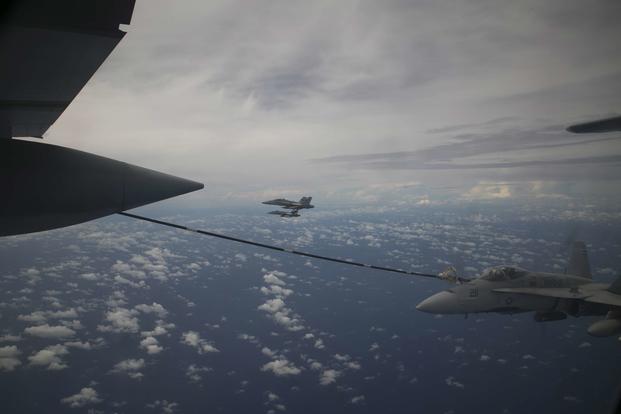The Marine Corps will equip its aviation squadrons with new water-activated strobe lights and could add new antennas to a location beacon that has been known to fail during emergencies.
In 2020, every Marine squadron will receive new signaling devices that automatically activate when they touch water, said Capt. Christopher Harrison, a Marine spokesman at the Pentagon. The "passive" strobe light will work even if a pilot is incapacitated, he added.
The Marine Corps is also considering ways to improve its URT-140 radio beacons, which are meant to help search-and-rescue crews locate missing aviators. The beacon is used in all Navy tactical aircraft -- except F-35 Joint Strike Fighters -- and is known to have malfunctioned.
"The Marine Corps is leveraging several funded initiatives to improve the beacon's reliability, including antenna extension kits," Harrison said.
Related: Marine Corps Finds Unprofessional Command Led to Fatal Midair Crash that Killed 6
A December 2018 midair collision that killed six Marines has raised a host of questions about the equipment and training aviators receive before carrying out risky missions. One of the Marines who died in the crash, Capt. Jahmar Resilard, was alive for hours after ejecting from his F/A-18D Hornet.
Resilard was floating in the Pacific Ocean off the coast of Japan but drowned about two hours before his body was located.
The captain's Hornet struck a KC-130 Hercules during an overnight training mission. He and his weapons officer, Capt. Austin Smith, ejected and parachuted into the ocean. Neither officer's location beacon worked, ProPublica reported last month in a lengthy investigation into the crash and the circumstances leading up to it.
Now-retired Lt. Col. James Compton, the former commanding officer of Marine All-Weather Fighter Attack Squadron 242 who was relieved after the accident, told ProPublica he'd tried to outfit the unit with replacement beacons. That was after the radio device had failed twice before, including when Capt. James Frederick -- another Hornet pilot -- died in the same region two years prior.
"But weeks before the [December 2018] crash, the Marine Corps ordered a halt to their use because they were not officially authorized," ProPublica reported.
As the "sole Program of Record for all F/A-18 variants in the Marine Corps," Harrison said the URT-140 is the only beacon authorized for use during flight operations.
Aside from problems with the beacon, the investigation into the Hornet and KC-130 collision found low safety and readiness rates for the all-weather fighter squadron. Since then, Harrison said, the Marine Corps has taken "significant actions" to improve the squadron's performance.
"Such efforts include sourcing an additional simulator to the squadron, as well as increasing the unaccompanied tour length in Okinawa and Iwakuni from 24 to 36 months to increase resident maintainer experience," he said.
The service declined to provide the squadron's past and current readiness data, citing operational security concerns.
The Marine Corps is working with Naval Air Systems Command to field the new strobe light to all the service's squadrons in 2020, Harrison said.
"Initial tests with the signaling device have been successful and will complement currently fielded equipment, such as the URT-140," he added.
-- Gina Harkins can be reached at gina.harkins@military.com. Follow her on Twitter @ginaaharkins.
Read more: GAO: Pentagon's Aircraft Readiness Goals Are a Stretch











